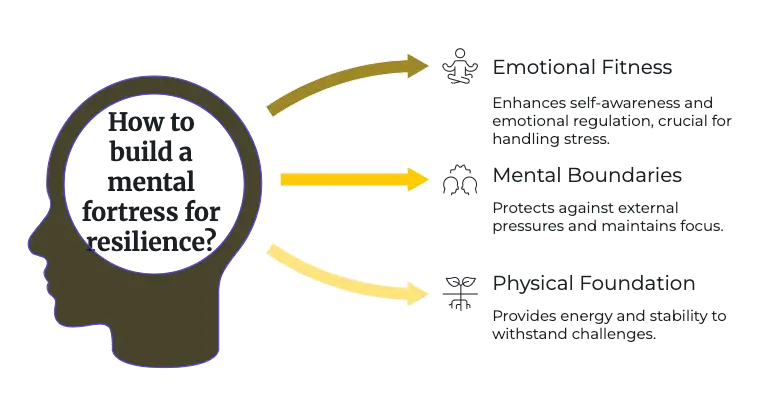In my entrepreneurial journey, I’ve faced countless moments when everything seemed to crumble beneath my feet. From nearly running out of money to dealing with failed acquisitions and difficult board meetings, I’ve experienced firsthand how critical mental resilience is for survival. These challenges tested not just my business acumen but my Entrepreneurial Mindset—the ability to stay adaptive, resilient, and forward-thinking in the face of adversity.
The most valuable lesson I’ve learned isn’t about business models or fundraising strategies—it’s about building what I call a “mental fortress”—a psychological foundation that protects you from external pressures while fostering growth, innovation, and perseverance.

What is a Mental Fortress?
A mental fortress represents the psychological infrastructure that shields entrepreneurs from external pressures while enabling clear thinking and decisive action. This concept goes beyond simple resilience—a comprehensive approach to mental well-being in high-pressure environments.
When I faced the collapse of a potential acquisition deal for my startup, my mental fortress allowed me to pivot quickly, shop the letter of intent to other potential buyers, and ultimately secure a deal that exceeded our original expectations. Two years earlier, without this mental foundation, a similar setback might have paralyzed me for weeks.
Foundation Elements of Your Mental Fortress
Building a robust mental fortress requires attention to several interconnected elements:
Emotional Fitness
Emotional fitness forms the cornerstone of entrepreneurial mental strength. Unlike emotional intelligence (which focuses on understanding emotions), emotional fitness represents “the capacity to think on your feet when the ground crumbles underneath you.” This quality enables you to maintain composure and clarity during crises rather than becoming overwhelmed by stress or anxiety.
Mental Boundaries
Clear mental boundaries establish distinctions between external circumstances and internal responses. Entrepreneurs with firm mental boundaries recognize that while they cannot control all external events, they maintain sovereignty over their reactions and decisions. These boundaries prevent external chaos from infiltrating internal thought processes, preserving decision-making capabilities during turbulent periods.
Physical Foundation
Physical well-being supports mental performance through four critical pillars: regular physical activity, nutritious eating habits, quality sleep, and effective stress management. These physical elements create the biological conditions necessary for optimal cognitive function and emotional regulation.
I learned this lesson the hard way when I experienced a near-burnout after working sixteen-hour days for months. My body refused to get out of bed one morning—a clear signal that I had neglected this crucial foundation.
Practical Exercises for Fortifying Mental Boundaries
Developing your mental fortress requires intentional practice through specific exercises to strengthen psychological boundaries and build resilience.
Mindfulness Meditation Practice
Mindfulness meditation is a powerful tool for cultivating present-moment awareness and reducing stress. This practice helps develop metacognition, the ability to observe thoughts without becoming entangled in them.
How to implement:
1 Find a quiet, comfortable space where
2. Sit in a relaxed but alert posture, either on a chair or cushion
3. Begin with several deep breaths, allowing your body to relax while maintaining mental alertness
4. Direct your attention to your breath, noticing the sensations of each inhalation and exhalation
5. When your mind inevitably wanders, gently redirect attention to your breath without self-criticism
6. Start with 5-minute sessions and gradually extend to 15-20 minutes daily
Regular mindfulness practice strengthens your ability to maintain focus amid distractions and respond thoughtfully rather than reactively to challenges.
Boundary Visualization Exercise
Establishing clear psychological boundaries helps distinguish between external circumstances and internal responses. The following exercise provides a tangible way to conceptualize personal boundaries:
1 . Using string or twine, create a circle approximately 3-4 feet in diameter on the floor
2. Stand in the center of this circle, which represents your core identity, values, and mental space
3. Everything within the circle symbolizes aspects of yourself—your beliefs, values, aspirations, and inner resources
4. Everything outside represents external factors—market conditions, competitor actions, and circumstances beyond your control
5. Reflect on what properly belongs inside your circle versus what should remain outside
6. Consider which external elements you’ve inappropriately internalized that contribute to stress or anxiety
7. This visualization helps recognize when you’re inappropriately assuming responsibility for factors beyond your control, enabling more transparent decision-making and reduced anxiety.
Positive Reframing Practice
How you interpret challenges significantly impacts your resilience and problem-solving capabilities. Positive reframing involves consciously shifting the perspective on difficulties from threats to opportunities for growth.
To develop this skill:
1. When facing a setback, consciously pause before reacting
2. Identify the automatic negative interpretation that arises
3. Challenge this interpretation by asking:
- “What potential opportunity exists within this challenge?”
- “What capabilities might I develop by addressing this situation?”
- “How might this difficulty prepare me for future success?”
- Record both the initial negative thought and your reframed positive perspective
This practice doesn’t involve denying reality but expanding perspective to include potential benefits alongside difficulties. Over time, positive reframing becomes increasingly automatic, contributing to greater resilience during adversity.
Intentional Failure Exercise
Counterintuitively, deliberately seeking small failures can strengthen entrepreneurial resilience by desensitizing fear responses and building failure recovery skills. This exercise involves:
1. Identifying low-stakes opportunities to attempt something complex or unfamiliar where failure is likely but consequences are minimal
2. Setting a weekly goal for experiencing at least one such failure
3. After each failure, document:
- What you learned from the experience
- How quickly you recovered emotionally
- How you might approach a similar situation differently next time
This practice normalizes failure as part of the entrepreneurial process while building rapid recovery capabilities. The emphasis shifts from avoiding failure to extracting maximum learning from inevitable setbacks.
Entrepreneurs Who Maintained Strong Mental Boundaries
Elon Musk: Resilience Through Repeated Failures
Elon Musk’s entrepreneurial journey exemplifies extraordinary resilience through potentially catastrophic failures. During SpaceX’s early years, Musk faced three consecutive rocket launch failures that depleted nearly all company resources. While external observers predicted inevitable failure, Musk maintained an unwavering focus on the technical problems rather than becoming emotionally overwhelmed by financial pressures.
His ability to separate external circumstances from internal resolve enabled him to persist where others would have abandoned the venture. Musk attributes this resilience to a specific mental approach: “If something is important enough, you should try, even if the probable outcome is failure.”
This philosophy demonstrates the mental fortress concept—external failures influenced strategic adjustments but never penetrated his core commitment to the mission.
Sara Blakely: Normalizing Failure as Growth
Sara Blakely, founder of Spanx and self-made billionaire, attributes much of her resilience to early mental training from her father, who deliberately normalized failure as a positive indicator of growth.
Growing up, Blakely’s father would regularly ask, “What did you fail at this week?” and express disappointment if she had nothing to report. This unusual parenting approach fundamentally reframed her relationship with failure—transforming it from something to fear into evidence of appropriate risk-taking and learning.
When manufacturers repeatedly refused to produce her prototype, Blakely’s mental framework allowed her to persist without internalizing rejections as personal failures. She maintained unwavering belief in her concept despite external skepticism.
Her story illustrates how early mental training established boundaries that prevented external rejection from diminishing internal confidence.
Howard Schultz: Maintaining Vision Through Rejection
Howard Schultz’s journey with Starbucks demonstrates how mental boundaries enable entrepreneurs to maintain vision despite significant external resistance.
After joining Starbucks as Director of Retail Operations, Schultz developed the vision for transforming the small coffee retailer into a national chain of European-style espresso bars. When the original owners rejected his concept, Schultz maintained clear boundaries between this external rejection and his internal conviction.
Schultz faced extraordinary difficulty raising the $1.6 million needed to launch his venture, receiving over 200 investor rejections. Throughout this process, he maintained clear separation between external skepticism and internal conviction. His mental fortress enabled him to persist through what he described as a “very painful time” without internalizing rejection as evidence of a flawed vision.
Building Your Mental Fortress
Developing your entrepreneurial mental fortress requires consistent practice and intentional cultivation of specific habits and perspectives:
Cultivate Emotional Intelligence
Check in with yourself regularly throughout the day. Pay attention to your emotional responses to challenges and develop awareness of triggers that compromise your mental boundaries. This self-awareness forms the foundation for preserving clear thinking during stressful situations.
Maintain a Positive but Realistic Mindset
This doesn’t involve denying difficulties but expanding perspective to include potential opportunities within challenges. Positive thinking enhances resilience and attracts collaborators who share your constructive approach.
Research published in Forbes highlights that entrepreneurs with positive mindsets are more likely to tackle challenges with optimism and creativity, converting potential setbacks into valuable learning opportunities.
Embrace Failure as a Learning Laboratory
Establish regular practices that normalize failure as part of the entrepreneurial process, such as weekly reflection on “productive failures” that generate valuable insights. This perspective reduces fear and accelerates innovation through increased willingness to experiment.
Establish Clear Mental Boundaries
Recognize that market conditions, investor feedback, and even business outcomes reflect a complex interplay of factors rather than definitive judgments about your capabilities or worth. These boundaries preserve decision-making clarity during turbulent periods.
Develop a Robust Physical Foundation
Consistent attention to exercise, nutrition, sleep, and stress management creates the biological conditions necessary for optimal cognitive function and emotional regulation. A strong physical foundation significantly enhances mental fortress resilience.
Final Thoughts
The entrepreneurial journey inevitably involves navigating uncertainty, setbacks, and periods of intense pressure. Building a mental fortress—a robust psychological infrastructure that protects core identity while enabling appropriate responses to challenges—represents perhaps the most critical determinant of entrepreneurial success.
Musk, Blakely, and Schultz’s examples demonstrate how mental boundaries enabled persistence through periods when rational external assessment would have predicted failure. Their success stemmed not from avoiding difficulties but from maintaining appropriate psychological separation between external circumstances and internal resolve.
Aspiring entrepreneurs can develop similar mental fortresses by implementing the practical exercises outlined in this article and consistently nurturing the characteristics of an entrepreneurial mindset. This psychological infrastructure doesn’t eliminate challenges but transforms how they’re experienced—from overwhelming threats into navigable obstacles that contain seeds of opportunity.
In a business landscape characterized by accelerating change and increasing uncertainty, the mental fortress concept offers entrepreneurs not just protection against adversity but a foundation for sustainable success and innovation. The entrepreneurs who thrive will invest as deliberately in their mental infrastructure as they do in their business strategies.
For more on building entrepreneurial resilience and developing the right mindset for success, join our Boundless Founder community at www.BoundlessFounder.co/join.











Responses